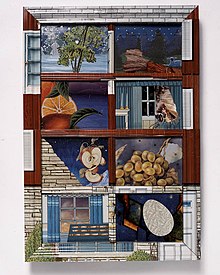Harriete Estel Berman
Harriete Estel Berman | |
|---|---|
| Born | 1952 (age 71–72) Harrisburg, PA |
| Nationality | American |
| Website | harrieteestelberman |
Harriete Estel Berman (born 1952) is an American artist known for her sculptures and jewelry made from post-consumer, recycled household goods, and her satirical explorations of women's roles in society.[1]
Early life and education[edit]
Berman was born in Harrisburg, Pennsylvania.[1] She attended Syracuse University, and was granted a BFA in 1974. In 1980, she earned an MFA from Tyler School of Art, Temple University.
In 1990, she was the Artist in Residence at the Cranbrook Academy of Art. She has also been a lecturer and teacher at California College of Arts & Crafts and Vermont College of Norwich University.[2]
She currently lives and works in California.[3]
Artistic career[edit]

Selected solo exhibitions include "grass\ 'gras\" (2000) at the Wustum Museum (now Racine Art Museum), "The Family of Appliances You Can Believe In," at Sybaris Gallery (1999), and the Barbican Center in London (1998).
Recent work includes commentary on the prevalence of standardized testing of students, including Pick Up Your Pencils, Begin,[4] a 12 x 28 foot curtain of pencils arranged in the form of a bell curve.[5]
Since 2001 Harriete Estel Berman has worked to provide information for artists and makers about professional practices. These efforts include the Professional Guidelines,[6] ASK Harriete[7] and the SNAG Professional Development Seminar.[8]
Collections[edit]
She has works in the permanent collections of the Detroit Institute of Arts, the Smithsonian American Art Museum,[9] the Tyler School of Art, and The Jewish Museum, New York, Philadelphia Museum of Art, Minneapolis Institute of Arts, Crocker Art Museum, Museum of Arts and Design, Columbus Museum of Art, Jewish Museum, Berlin, Germany,[10] Museum of Fine Arts, Boston, National Ornamental Metal Museum, Oakland Museum of California, Racine Art Museum,[11] Yeshiva University Museum, and The Congregation Emanu-el.
Notes[edit]
- ^ a b "Harriete Estel Berman". Smithsonian American Art Museum. Retrieved 30 March 2014.
- ^ "Harriete Estel Berman". FiberScene. Retrieved 30 March 2014.
- ^ "Bio for Harriete Estel Berman". Harriete Berman. Archived from the original on 18 July 2014. Retrieved 30 March 2014.
- ^ "Pencils". Harriete Estel Berman.
- ^ Hanus, Julie K. "Craft in Action: Pencils Make a Point" (PDF). American Craft (December/January 2012): 38. Archived from the original (PDF) on 29 March 2014. Retrieved 30 March 2014.
- ^ "Professional Guidelines". Harriete Estel Berman.
- ^ "Ask Harriete". Ask Harriete.
- ^ Goldsmiths, Society of North American. "Professional Development Seminar - Society of North American Goldsmiths". www.snagmetalsmith.org.
- ^ "Harriete Estel Berman | Smithsonian American Art Museum". americanart.si.edu.
- ^ "Jewish Museum Berlin". www.jmberlin.de.
- ^ "Manuf®actured: The conspicuous transformation of everyday objects | Artists | Harriete Estel Berman". www.museumofcontemporarycraft.org.
External links[edit]
- Famous Selection, from "The Deceiver and the Deceived series", 1995-1996, in the collection of the Smithsonian American Art Museum
- 1952 births
- Living people
- 20th-century American sculptors
- 20th-century American women artists
- Artists from Harrisburg, Pennsylvania
- California College of the Arts faculty
- Syracuse University College of Visual and Performing Arts alumni
- Temple University Tyler School of Art alumni
- 21st-century American artists
- 21st-century American women artists
- American women academics
- 20th-century American women sculptors
